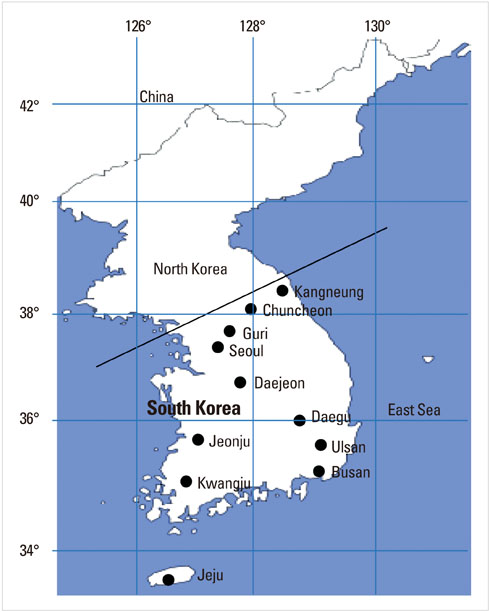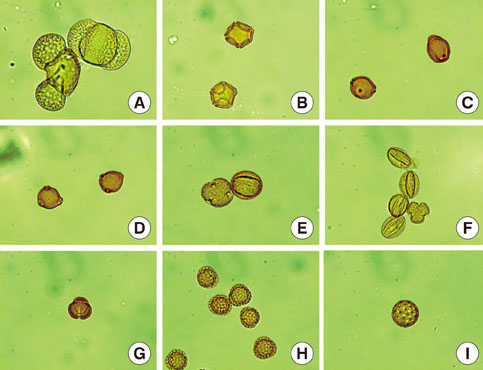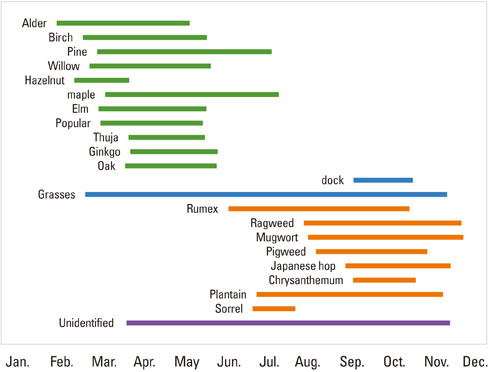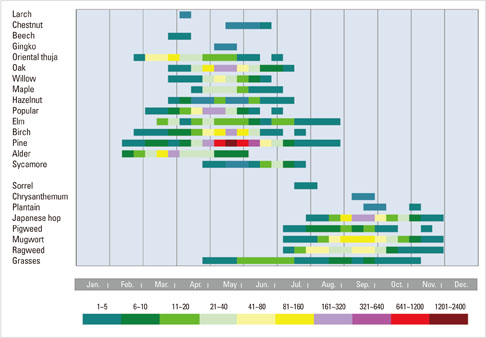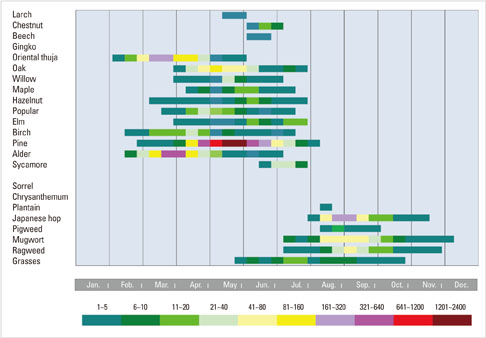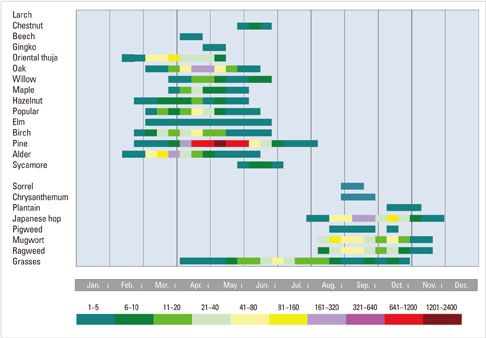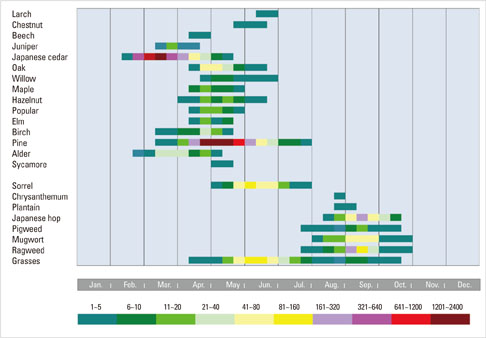The Revised Edition of Korean Calendar for Allergenic Pollens
- Affiliations
-
- 1Department of Pediatrics , College of Medicine, Hanyang University, Seoul, Korea. jaewonoh@hanyang.ac.kr
- 2Department of Pediatrics, Daegu Fatima Hospital, Daegu, Korea.
- 3Department of Pediatrics, Busan St. Maria Hospital, Busan, Korea.
- 4Department of Pediatrics, Jeonju Presbyterian Medical Center, Jeonju, Korea.
- 5Department of Pediatrics, Kwangju Veteran's Hospital, Kwangju, Korea.
- 6Department of Pediatrics, Kangneung Asan Hospital, Kangneung, Korea.
- 7Department of Pediatrics, School of Medicine, Kangwon National University, Chuncheon, Korea.
- 8Department of Pediatrics, Ulsan Dongkang Hospital, Ulsan, Korea.
- 9Applied Meteorology Research Laboratory, National Institute of Meteorological Research, Seoul, Korea.
- KMID: 2130372
- DOI: http://doi.org/10.4168/aair.2012.4.1.5
Abstract
- The old calendar of pollens did not reflect current pollen distribution and concentrations that can be influenced by changes of weather and environment of each region in South Korea. A new pollen calendar of allergenic pollens was made based on the data on pollen concentrations obtained in eight regions nationwide between 1997 and 2009. The distribution of pollen was assessed every day at 8 areas (Seoul, Guri, Busan, Daegu, Jeonju, Kwangju, Kangneung, and Jeju) for 12 years between July 1, 1997 and June 30, 2009. Pollens were collected by using Burkard 7-day sampler (Burkard Manufacturing Co Ltd, UK). Pollens which were stained with Calberla's fuchsin staining solution were identified and counted. Pine became the highest pollen in May, and the pollen concentrations of oak and birch also became high. Ragweed appeared in the middle of August and showed the highest pollen concentration in the middles of September. Japanese hop showed a high concentration between the middle of August and the end of September, and mugwort appeared in the middles of August and its concentration increased up until early September. In Kangneung, birch appeared earlier, pine showed a higher pollen concentration than in the other areas. In Daegu, Oriental thuja and alder produced a large concentration of pollens. Pine produced a large concentration of pollens between the middle of April and the end of May. Weeds showed higher concentrations in September and mugwort appeared earlier than ragweed. In Busan the time of flowering is relatively early, and alder and Oriental thuja appeared earliest among all areas. In Kwangju, Oriental thuja and hazelnut appeared in early February. Japanese cedar showed the highest pollen concentration in March in Jeju. In conclusion, update information on pollen calendar in South Korea should be provided for allergic patients through the website to manage and prevent the pollinosis.
MeSH Terms
Figure
Cited by 15 articles
-
A Six-Year Study on the Changes in Airborne Pollen Counts and Skin Positivity Rates in Korea: 2008–2013
Hye Jung Park, Jae-Hyun Lee, Kyung Hee Park, Kyu Rang Kim, Mae Ja Han, Hosoeng Choe, Jae-Won Oh, Chein-Soo Hong
Yonsei Med J. 2016;57(3):714-720. doi: 10.3349/ymj.2016.57.3.714.Clinical diagnostic guidelines for allergic rhinitis: diagnosis
Young Hyo Kim, Hyeon-Jong Yang, Jeong-Hee Choi, Dong-Kyu Kim, Young Yoo, Bora Lee, Mi-Ae Kim, Bong-Seong Kim, Won-Young Kim, Jeong Hee Kim, Yang Park, So Yeon Park, Woo Yong Bae, Keejae Song, Min-Suk Yang, Sang Min Lee, Young-Mok Lee, Hyun Jong Lee, Jae-Hong Cho, Hye Mi Jee, Young-Il Koh,
J Korean Med Assoc. 2017;60(1):81-88. doi: 10.5124/jkma.2017.60.1.81.Revised Pollen Calendar in Korea
Jung-Won Park
Allergy Asthma Immunol Res. 2020;12(2):171-172. doi: 10.4168/aair.2020.12.2.171.Allergenic Pollen Calendar in Korea Based on Probability Distribution Models and Up-to-Date Observations
Ju-Young Shin, Mae Ja Han, Changbum Cho, Kyu Rang Kim, Jong-Chul Ha, Jae-Won Oh
Allergy Asthma Immunol Res. 2020;12(2):259-273. doi: 10.4168/aair.2020.12.2.259.Identification of immunoglobulin E binding components of two major tree pollens, birch and alder
Moon-Gyung Yoon, Mi-Ae Kim, Hyun-Jung Jin, Yoo-Seob Shin, Hae-Sim Park
Allergy Asthma Respir Dis. 2013;1(3):216-220. doi: 10.4168/aard.2013.1.3.216.Identification of IgE binding components of two major weed pollens, ragweed and mugwort
Moon-Gyung Yoon, Mi-Ae Kim, Hyun-Jung Jin, Yoo-Seob Shin, Hae-Sim Park
Allergy Asthma Respir Dis. 2014;2(5):337-343. doi: 10.4168/aard.2014.2.5.337.Evaluation of the association of vegetation of allergenic plants and pollinosis with meteorological changes
Joo-Hwa Kim, Jae-Won Oh, Ha-Baik Lee, Seong-Won Kim, Hai-Lee Chung, Myung-Hee Kook, Kang-Seo Park, Bong-Seong Kim, Ja-Kyung Kim, Dong-Jin Lee, Won-Ki Paik, Kyu-Rang Kim, Hey-Lim Lee, Young-Jin Choi, Seung-Do Yu, Jeong-Hwa Kim, Yong-Seong Cho
Allergy Asthma Respir Dis. 2014;2(1):48-58. doi: 10.4168/aard.2014.2.1.48.Changes of aeroallergen sensitization in children with asthma or allergic rhinitis from a tertiary referral hospital in Seoul over 10 years
Young-Ho Jung, Keum-Hee Hwang, Song-I Yang, En Lee, Kyung-Hee Kim, Min-Ju Kim, Geun-Mi Park, Ju-Hee Seo, Hyung Young Kim, Jinho Yu, Soo-Jong Hong
Allergy Asthma Respir Dis. 2014;2(2):97-102. doi: 10.4168/aard.2014.2.2.97.Pollen allergy plants in Korea
Chein-Soo Hong
Allergy Asthma Respir Dis. 2015;3(4):239-254. doi: 10.4168/aard.2015.3.4.239.Evaluation of the association between pollen count and the outbreak of allergic disease
Ha-Na Kang, Hey Suk Yun, Young-Jin Choi, Jae-Won Oh, Ui-Young Min, Yoon-Sook Heo, Young-Seop Lee, Mijin Kim, Kyu Rang Kim, Baek-Jo Kim
Allergy Asthma Respir Dis. 2016;4(6):415-422. doi: 10.4168/aard.2016.4.6.415.Characteristics of airborne pollen in Incheon and Seoul (2015–2016)
Hye Ju So, Soon Jeong Moon, Seon Yeong Hwang, Jeong Hee Kim, Hae Ji Jang, Jung Heum Jo, Tae Jung Sung, Dae Hyun Lim
Asia Pac Allergy. 2017;7(3):138-147. doi: 10.5415/apallergy.2017.7.3.138.Subcutaneous Immunotherapy in Patients with Fagales Pollen-Induced Oral Allergy Syndrome
Nasil Kong, Sunyoung Kim, Sang Chul Lee, Kyung Hee Park, Jae-Hyun Lee, Jung-Won Park
Yonsei Med J. 2019;60(4):389-394. doi: 10.3349/ymj.2019.60.4.389.Patterns of Inhalant Allergen Sensitization and Geographical Variation in Korean Adults: A Multicenter Retrospective Study
Min-Gyu Kang, Mi-Yeong Kim, Woo-Jung Song, Sujeong Kim, Eun-Jung Jo, Seung-Eun Lee, Jae-Woo Kwon, Sang-Min Lee, Chan-Sun Park, Hye-Kyung Park, Heung-Woo Park, Yoon-Seok Chang, Jaechun Lee, Young-Min Lee, Young-Koo Jee, Jong-Myung Lee, Inseon S. Choi, Sang-Heon Cho
Allergy Asthma Immunol Res. 2017;9(6):499-508. doi: 10.4168/aair.2017.9.6.499.Cross-allergenicity between dandelion and major weed pollens
Ji Hye Kim, Moon-Kyung Yoon, Mi-Ae Kim, Yoo-Seob Shin, Young Min Ye, Hae-Sim Park
Allergy Asthma Respir Dis. 2015;3(5):358-364. doi: 10.4168/aard.2015.3.5.358.Recent changing pattern of aeroallergen sensitization in children with allergic diseases: A single center study
Su-Jin Lee, Jung-Min Kim, Hyo-Bin Kim
Allergy Asthma Respir Dis. 2019;7(4):186-191. doi: 10.4168/aard.2019.7.4.186.
Reference
-
1. Lewis WH, Vinay P, Zenger VE. Airborne and allergenic pollen of North America. 1983. Baltimore: Johns Hopkins University Press.2. Min YG. The pathophysiology, diagnosis and treatment of allergic rhinitis. Allergy Asthma Immunol Res. 2010. 2:65–76.3. Jung JW, Choi JC, Shin JW, Kim JY, Park IW, Choi BW. Clinical characteristics according to sensitized allergens in adult Korean patients with bronchial asthma. Allergy Asthma Immunol Res. 2010. 2:102–107.4. Taylor G, Walker J, Backley CH. 1820-1900: A detailed description of the astonishing achievement of Backley in describing the causes of hay fever. Clin Allergy. 1973. 3:103–108.5. Lewis WH, Imber WE. Allergy epidemiology in the St. Louis, Missouri, area: II grasses. Ann Allergy. 1975. 35:42–50.6. Anderson JH. Allergenic airborne pollen and spores in Anchorage, Alaska. Ann Allergy. 1985. 54:390–399.7. Kang SY, Min KU. Aerobiological and allergic study of pollen in Seoul. Allergy. 1984. 4:1–20.8. Oh YC, Kim HA, Kang IJ, Cheong JT, Kim SW, Kook MH, Kim BS, Lee HB, Oh JW. Evaluation of the relationship between pollen count and the outbreaks of allergic diseases. Pediatr Allergy Respir Dis. 2009. 19:354–364.9. Oh JW, Lee HB, Lee HR, Pyun BY, Ahn YM, Kim KE, Lee SY, Lee SI. Aerobiological study of pollen and mold in Seoul, Korea. Allergol Int. 1998. 47:263–270.10. Oh JW, Lee HR, Kim JS, Lee KI, Kang YJ, Kim SW, Kook MH, Kang HY, Kim JS, Lee MH, Lee HB, Kim KE, Pyun BY, Lee SI, Han MJ. Aerobiological study of pollen and mold in the 10 states of Korea. Pediatr Allergy Respir Dis. 2000. 10:22–33.11. Oh JW, Kang IJ, Kim SW, Kook MH, Kim BS, Shin KS, Hahn YS, Lee HB, Shon MH, Cheong JT, Lee HR, Kim KE. The correlation between increased sensitization rate to weeds in children and the annual increase in weed pollen in Korea. Pediatr Allergy Respir Dis. 2006. 16:114–121.12. Brown HM, Irving KR. The size and weight of common allergenic pollens. An investigation of their number per microgram and seze distribution. Acta Allergol. 1973. 28:132–138.13. Potter PC, Cadman A. Pollen allergy in South Africa. Clin Exp Allergy. 1996. 26:1347–1354.14. Esch RE, Bush RK. Adkinson NF, Middleton E, Yunginger JW, Busse WW, Bochner BS, Holgate ST, Simons FE, editors. Aerobiology of outdoor allergens. Middleton's allergy principles and practice. 2003. 6th ed. St. Louis: Mosby;529–555.15. Solomon WR, Weber RW, Dolen WK. Bierman CW, Pearlman DS, Shapiro GG, Busse WW, editors. Common allergenic pollen and fungi. Allergy, asthma, and immunology from infancy to adulthood. 1996. 3rd ed. Philadelphia: WB Saunders;93–114.16. Solomon WR, Burge HA, Muilenberg ML. Allergen carriage by atmospheric aerosol. I. Ragweed pollen determinants in smaller micronic fractions. J Allergy Clin Immunol. 1983. 72:443–447.17. Agarwal MK, Swanson MC, Reed CE, Yunginger JW. Immunochemical quantitation of airborne short ragweed, Alternaria, antigen E, and Alt-I allergens: a two-year prospective study. J Allergy Clin Immunol. 1983. 72:40–45.18. Marsh D. Sela M, editor. Allergens and the genetics of allergy. The antigens. 1975. Vol. 3. New York: Academic Press;271–276.19. Løwenstein H. Quantitative immunoelectrophoretic methods as a tool for the analysis and isolation of allergens. Prog Allergy. 1978. 25:1–62.20. Smith EG. Sampling and identifying allergenic pollens and molds: an illustrated identification manual for air samplers. 1990. San Antonio: Blewstone Press.21. Ziska LH, Caulfield FA. Rising CO2 and pollen production of common ragweed (Ambrosia artemisiifolia), a known allergy-inducing species: implications for public health. Australian J Plant Physiol. 2000. 27:893–898.22. Ziska LH, Gebhard DE, Frenz DA, Faulkner S, Singer BD, Straka JG. Cities as harbingers of climate change: common ragweed, urbanization, and public health. J Allergy Clin Immunol. 2003. 111:290–295.23. Wayne P, Foster S, Connolly J, Bazzaz F, Epstein P. Production of allergenic pollen by ragweed (Ambrosia artemisiifolia L.) is increased in CO2-enriched atmospheres. Ann Allergy Asthma Immunol. 2002. 88:279–282.24. Singer BD, Ziska LH, Frenz DA, Gebhard DE, Straka JG. Increasing Amb a 1 content in common ragweed (Ambrosia artemisiifolia) pollen as a function of rising atmospheric CO2 concentration. Funct Plant Biol. 2005. 32:667–670.25. Park KJ, Kim HA, Kim KR, Oh JW, Lee SY, Choi YJ. Characteristics of regional distribution of pollen concentration in Korean Peninsula. Korean J Agric Forest Meterol. 2008. 10:167–176.
- Full Text Links
- Actions
-
Cited
- CITED
-
- Close
- Share
- Similar articles
-
- Allergenic Pollen Calendar in Korea Based on Probability Distribution Models and Up-to-Date Observations
- Comparison on the Embryological Terms between the Korean Veterinary Anatomical Terminology (2008) and the Korean Anatomical Terminology (1996)/the Korean Medical Association: Medical Terminology (2009)
- Survey of the Airborne Pollens in Seoul, Korea
- Stability of extracts from pollens of allergenic importance in Korea
- Evaluation of the allergenic relationship between Humulus japonicus and Humulus lupulus pollen allergens

